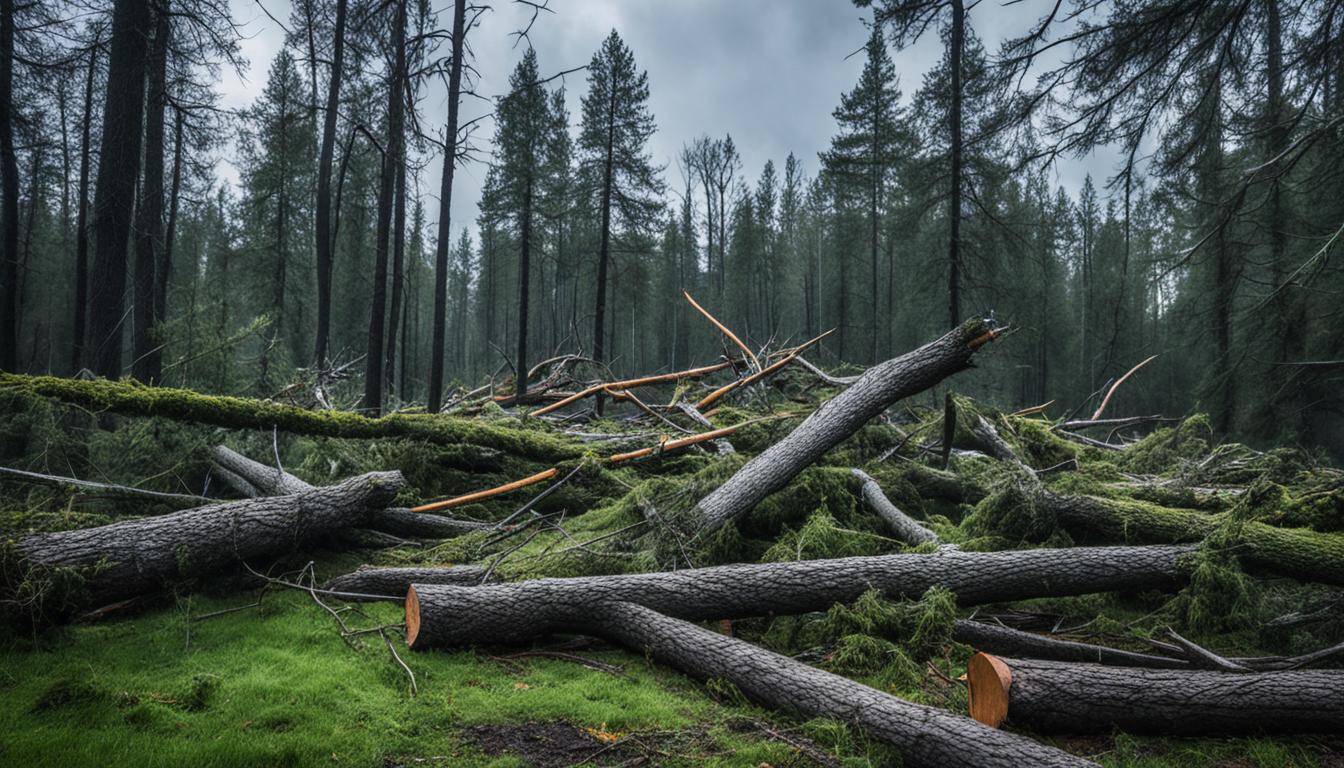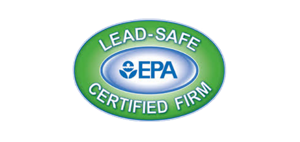The wind is often overlooked but plays a big role in sculpting our world. It moves from a gentle touch to a powerful force, causing harm to what’s around us. Wind damage can range from a small inconvenience to very serious problems. This piece aims to show how wind affects buildings, nature, and our lives, starting an important conversation on how to protect against it.
Wind can be peaceful or a fierce storm, acting as both a friend and a foe in the environment. It moves freely but can also quickly turn into destruction. Understanding wind damage is vital for protecting against unpredictable weather events. It shows why preparing for the worst is crucial in areas prone to severe storms.
Key Takeaways
- Understanding wind damage and its various forms is crucial for effective weather hazard preparedness.
- Property destruction by wind ranges from superficial to severe and requires diverse protective strategies.
- Environmental impacts from wind not only alter landscapes but can also disrupt ecosystems.
- Safeguard measures are paramount in areas prone to violent gusts and persistent high winds.
- Fostering community awareness about the risks and potential damages caused by wind is key to collective safety.
Understanding Damaging Winds
Severe weather often brings damaging winds that act like straight-line winds. These strong winds move straight and not in circles like tornadoes do. They come from thunderstorm downdrafts. Knowing how these winds start helps us understand their dangers.
Damaging winds can be as strong as 50-60 mph or more. They can cause a lot of damage, similar to tornadoes. Being aware of this strength is key for getting ready for bad weather.
- Origin of Damaging Winds: They begin in severe thunderstorms. Cold air dives down and hits the ground, then spreads out quickly.
- Characteristics of Straight-Line Winds: They move in one direction over large areas. This is unlike tornadoes, which are more focused.
- Impact of Thunderstorm Downdrafts: When these downdrafts happen, they can create sudden strong winds. These winds can cause a lot of trouble in towns and cities.
- Recognition of Severe Wind Thresholds: It’s important to know the wind strength that can cause serious harm. This knowledge helps to warn people early and prevent damage.
Understanding damaging winds is crucial for predicting the weather better. It also makes communities more ready for disasters. This includes having good plans for when bad winds hit.
The Extent of Thunderstorm Wind Damage
Thunderstorm winds cause lots of severe weather reports, especially in the lower U.S. These winds move fast and damage a lot. Sometimes, they do more damage than tornados. This makes them a major concern for weather experts and safety groups.
These winds can reach up to 100 mph. They damage wide areas, causing trouble and high costs. They smash buildings, knock down trees, and cut off power for miles around.
- Many severe weather reports highlight thunderstorm winds’ role in extreme weather destruction.
- The recovery from this damage is hard, impacting communities a lot. It underlines the need for better forecasts and emergency plans.
Knowing how these winds work and the big damage they do helps plans to lessen their impact. This shows why strong building rules, community education, and emergency plans are crucial. They help reduce the harm from thunderstorm damage.
Risks to Various Populations from Severe Winds
Severe winds can be especially dangerous for certain groups, like those living in mobile homes. These light structures are easily damaged by strong winds. People who are elderly, have disabilities, or are poor face more risks in such conditions. It’s key to keep them safe and prepare the community and emergency teams to help.
The elderly, people with disabilities, and those who are poor are at high risk during severe winds. For them, mobile home safety is a big concern. These dwellings can get seriously damaged by winds. Safety measures should specifically target these groups to lower the risks.
- Installation of tie-downs and anchor systems strong enough to withstand winds of over 80 mph.
- Regular maintenance checks to ensure structural integrity and immediate repair of any damages that could weaken resilience against winds.
- Community planning to include safe areas where residents of mobile homes can evacuate during high-risk weather conditions.
Focusing on safety for high-risk groups living in mobile homes can greatly lessen the danger of severe winds. It involves clear communication, keeping homes in good shape, and setting proper rules. The aim is to protect everyone from the harmful effects of severe winds, no matter their home or situation.
Destructive Impact of Hurricanes
Hurricanes are known for their high wind speeds and extreme impacts on the land. They can change the area, take down buildings, and cause a lot of flooding. This makes them very dangerous for those living by the coast.
When a hurricane hits, it causes a lot of damage to buildings and roads. The wind is so strong that it can tear off roofs or break windows. This can make houses or even whole buildings fall down. Not just that, power lines may fall, causing outages and creating others dangers.
Not only do hurricanes bring strong winds but also big waves that flood the land. This flooding can be so bad that people can’t fix things for a long time. It also means that the water can be dirty, which is unsafe, and it might hurt the places where animals live.
- Structural damage from high-speed winds, including the dismantling of buildings and homes.
- Flood damage due to storm surges, severely impacting coastal zones and beyond.
- Ecological impact, with extensive harm to both marine and terrestrial ecosystems.
When a hurricane brings wind and water damage together, it can be very bad. It can cause problems that last for a long time. Understanding how hurricanes hurt the land and what they can do is important. It helps people get ready and recover after a storm.
Types of Damaging Winds and Their Effects
Straight-line wind damage, gust fronts, and derecho storms can all cause severe effects. They impact both properties and safety in significant ways. This discussion delves into how these strong winds form and their consequences.
Straight-Line Wind Damage: These winds move uniformly and can destroy vast areas. They often come from severe thunderstorms. These windstorms are known for causing big property damage, like roofs tearing off and windows breaking.
Gust Fronts: Gust fronts bring sudden changes, like a swift wind shift and cooler air. Such shifts can shake buildings. With the first strong wind often comes heavy rain, making unsecured structures vulnerable. Quick windstorm safety actions are essential in these times.
Derecho Storms: Derecho storms are long-lasting and cover wide areas. Fueled by severe thunderstorms, they can cause damage over many places. Their strength and duration lead to widespread destruction.
- Knowing how these winds work is key to getting ready and managing emergencies.
- Building structures that can stand against strong winds helps reduce damage.
- Raising community awareness and practicing safety measures can greatly increase windstorm safety.
Understanding these powerful wind types is vital for creating safety plans and better building designs. Knowing what can happen helps in preparing for the worst. Being aware and ready can save lives and keep properties safe from straight-line wind damage, gust front impacts, and derecho storms.
Proactive Measures and Wind Insurance in Florida
In Florida, storms are common, making wind insurance vital. It’s crucial for homeowners to take steps to protect their homes. This can lessen the impact of storm damage.
Creating a hurricane-resistant infrastructure is key. Actions like adding strong windows and doors can help a lot. Other steps, such as reinforcing the roof, also play a big part.
- Installing impact-resistant windows and doors
- Strengthening roof attachments to enhance wind resistance
- Using hurricane straps to secure the structure of the home
There are other smart moves too. For instance, it’s good to keep trees trimmed and secure loose outdoor items before a storm. Regular home check-ups also matter to find and fix weak spots.
- Regular maintenance and trimming of trees close to the building.
- Securing loose items that could become projectiles in high winds.
- Conducting seasonal inspections to identify and rectify potential vulnerabilities.
While these steps come with some costs, they’re worth it. They can save big money on repairs later. Thinking about wind insurance is important. It offers peace of mind and protection from Florida’s stormy weather.
Conclusion
We’ve looked at the challenges that strong winds bring and why we must act to reduce their harm. Whether it’s a powerful storm or a hurricane, winds can cause a lot of damage. They remind us how important it is to be ready for any weather. A prepared community can protect its people, houses, and the environment.
Severe winds show us what we need to work on, like protecting our buildings and keeping people safe. Being ready is key to making our areas strong against wind damage. Knowing what to do helps everyone stay safer when winds are strong. This teamwork is very important.
This article calls for better plans to deal with strong winds. We need to be ready for nature’s powerful side as we move forward. By planning and taking smart actions, we can lessen the impact of destructive winds. This way, we look ahead to a time when we’re strong against the wind’s power. Contact Clean Image Restoration today for reliable and professional wind & storm damage services.









